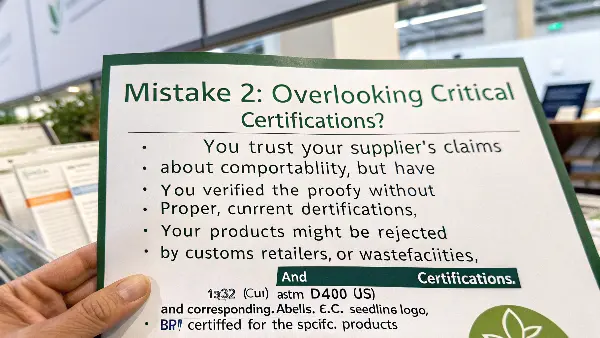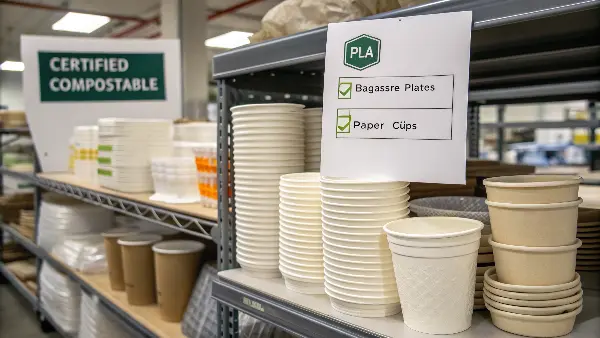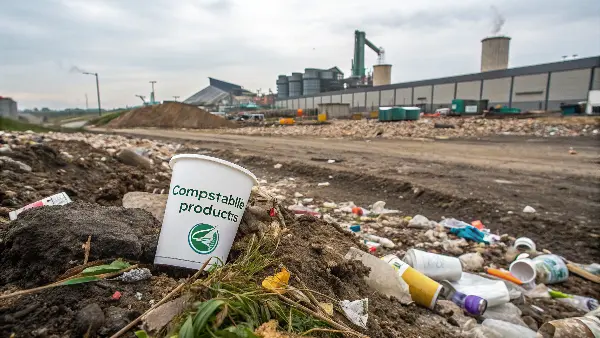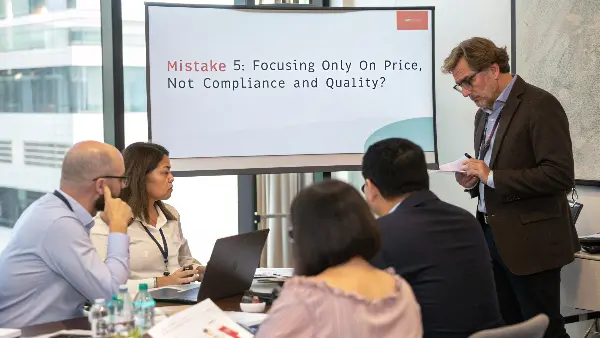Sourcing biodegradable products seems straightforward, but hidden pitfalls can cost you time, money, and reputation. Are you sure your sustainable sourcing strategy is sound, avoiding common errors? Let’s uncover the frequent mistakes importers face.
Common errors include confusing terminology like "biodegradable" vs "compostable," overlooking essential certifications (EN13432/ASTM D6400), ignoring material limitations, neglecting end-of-life infrastructure assessment, and focusing solely on unit price over compliance and overall value.
Navigating the world of eco-friendly products requires careful attention. Importers like Jacky in Canada need reliable information to ensure the products they source meet environmental claims and market regulations. At Ecosourcecn, we often see buyers stumble into the same traps. Understanding these potential mistakes is the first step toward building a truly sustainable and successful product line. Let’s look at five frequent errors.
Mistake 1: Confusing "Biodegradable" with "Compostable"?
You found a supplier offering "biodegradable" items at a great price, but is that term meaningful? Relying on vague claims can lead to non-compliant products and accusations of greenwashing. It’s a common point of confusion.
"Biodegradable" simply means something breaks down naturally over time, but without specifying conditions or timeframe. "Compostable" means it breaks down into non-toxic components under specific (usually industrial) composting conditions within a set period (e.g., 180 days).
This distinction is absolutely critical, especially for importers like Jacky targeting eco-conscious markets. The term "biodegradable" alone is often too ambiguous to meet regulatory standards or consumer expectations for eco-products. Many things are biodegradable eventually – even some conventional plastics – but they might take hundreds of years or leave harmful residues. Compostable products, however, must meet specific standards like EN 13432 (Europe) or ASTM D6400 (North America). These standards verify:
Key Requirements for Compostability
- Disintegration: The item must physically break down into small fragments within a specific timeframe (e.g., 12 weeks) in a composting environment.
- Biodegradation: A high percentage (e.g., 90%) of the organic carbon must convert to CO2 within a set period (e.g., 6 months).
-
No Harmful Residues: The resulting compost must be non-toxic and safe for plant growth, with heavy metals below strict limits.
I remember early in my career working with a client who had ordered thousands of "biodegradable" cups, only to find they couldn’t market them as eco-friendly in California because the term was restricted without proper compostability certification. Always ask for specific standards and certifications, not just vague terms. Relying on "biodegradable" can be a costly mistake.Term Meaning Timeframe Conditions Standard Examples Market Relevance Biodegradable Breaks down by natural processes Unspecified Unspecified None specific Often vague, potentially misleading Compostable Breaks down into non-toxic compost Specified Specific (Industrial) EN 13432, ASTM D6400 Meets regulations, verifiable Mistake 2: Overlooking Critical Certifications?
You trust your supplier’s claims about compostability, but have you verified the proof? Without proper, current certifications, your products might be rejected by customs, retailers, or waste facilities, damaging your brand.
Always demand and verify relevant certifications like EN 13432 (EU), ASTM D6400 (US), and corresponding labels (e.g., Seedling logo, BPI Certified) for the specific products you are importing to ensure compliance and market acceptance.

Certifications are non-negotiable in the world of compostable products. They are the proof that an item meets the stringent requirements we discussed earlier. For Jacky importing into Canada, BPI (Biodegradable Products Institute) certification, which uses ASTM D6400, is crucial. For European markets, the Seedling logo (based on EN 13432) or TÜV Austria’s OK compost INDUSTRIAL are key. Here’s why overlooking them is a mistake:
Importance of Verification
- Market Access: Many regions and retailers legally require these certifications to label and sell products as "compostable." Without them, you might face import barriers or fines.
- Credibility: Certifications build trust with consumers and commercial composters. They show you’ve done your due diligence.
- Avoiding Greenwashing: Relying on supplier assurances without proof can lead to unintentional greenwashing if the products don’t actually meet standards.
It’s not enough for a supplier to say their products are certified. You need to verify it. Ask for the certification documents for the specific product SKU you are buying, not just a general certificate for the material. Check the expiry date. You can often verify certifications directly through the certifying body’s online database (e.g., BPI’s certified product catalog). At Ecosourcecn, providing clear, verifiable certification documentation is a standard part of our process because we know how vital it is for our clients.Mistake 3: Ignoring Material Suitability and Shelf Life?
The product is certified compostable, but will it actually work for your specific application? Choosing the wrong material or overlooking storage needs can lead to product failures and unhappy customers. Performance still matters.
Assess if the material properties (e.g., heat tolerance, moisture resistance, rigidity, shelf life) match your product’s intended use and storage conditions. PLA, bagasse, and paper all have different strengths and weaknesses.

Eco-friendly materials often behave differently than traditional plastics. Ignoring these differences is a common path to problems. For example:
Material Considerations
- PLA (Polylactic Acid): Often used for cold cups, cutlery, and clear containers.
- Strength: Clear, relatively rigid.
- Weakness: Low heat tolerance (typically below 40-50°C or 110-120°F). Can warp in hot cars or dishwashers. Not ideal for hot liquids unless it’s CPLA (crystallized PLA). Limited shelf life (can become brittle over 1-2 years, especially in humid conditions).
- Bagasse (Sugarcane Fiber): Used for plates, bowls, clamshells.
- Strength: Good heat tolerance (suitable for hot foods/microwaves), grease-resistant (often).
- Weakness: Can absorb moisture over time if holding liquids for extended periods (unless lined/treated), potentially becoming less rigid. Requires dry storage.
- Paper: Used for cups (often PLA-lined for liquids), plates, bags.
- Strength: Lightweight, printable. Sourcing (FSC certified) is key.
- Weakness: Needs coating (like PLA) for liquid barrier, which affects compostability. Can lose strength when wet.
Jacky needs to consider: Will the container hold hot soup? Will the cutlery be used for tough foods? How long will products sit in a warehouse? We once helped a client switch from standard PLA to CPLA cutlery after they experienced issues with utensils softening when used with very hot dishes. Matching the material to the application and understanding storage needs prevents costly mistakes.Mistake 4: Forgetting About End-of-Life Infrastructure?
Your compostable products are certified and suitable, but can your customers actually compost them? Selling products designed for industrial composting in areas lacking such facilities undermines the environmental benefit and confuses users.
Investigate the availability and accessibility of industrial composting facilities in your target market that accept food-soiled packaging. Without proper disposal infrastructure, compostable items may end up in landfills, negating their purpose.

This is a crucial, yet often overlooked, piece of the puzzle. The "eco" benefit of compostable packaging is only fully realized when it’s actually composted. If the primary disposal method available to end-consumers is landfill or incineration, the product’s compostability becomes irrelevant in practice. For Jacky in Canada, the situation varies significantly by province and municipality. Some Canadian cities have robust green bin programs that accept certified compostable packaging, while others don’t.
Why Infrastructure Matters
- Achieving Circularity: The goal is to turn waste into valuable compost. This requires collection systems and processing facilities.
- Consumer Behavior: If composting isn’t easy or available, consumers will likely trash the item, potentially feeling misled by "compostable" claims.
- Contamination Issues: Tossing compostables into recycling bins contaminates the recycling stream. Clear communication about how and where to dispose of items is essential.
Before committing to a large import order, research the end-of-life options in your key sales regions. Check municipal waste management websites, talk to potential large customers (like event venues or institutions) about their waste streams, and consider clear on-package disposal instructions. Sometimes, a product that is recyclable (if made from suitable materials and clean) might be a more practical "eco" choice in a region with strong recycling but weak composting infrastructure. We guide clients like Jacky through this assessment as part of our service at Ecosourcecn.Mistake 5: Focusing Only on Price, Not Compliance and Quality?
Getting the lowest unit price seems like a win, but what if it leads to compliance issues or poor quality? Sacrificing essential checks and supplier vetting for a slightly lower cost often results in bigger expenses down the road.
Evaluate the total cost, including compliance verification, quality assurance, potential risks of rejected shipments, and the value of a reliable, transparent supplier. The cheapest option isn’t always the best value.

It’s tempting to choose the supplier with the absolute lowest price per unit. However, in the specialized field of biodegradable and compostable products, this can be a dangerous trap. We’ve seen importers face significant problems because they prioritized saving a few cents per item over due diligence:
Hidden Costs of the Cheapest Option
- Non-Compliance: The supplier might cut corners on certified materials or processes, leading to products that don’t meet EN 13432 or ASTM D6400 standards, even if claimed. This risks shipment rejection, fines, or legal issues.
- Poor Quality: Lower prices can mean thinner materials, inconsistent sizing, structural weaknesses (e.g., leaky cups, flimsy cutlery), or shorter shelf life, leading to customer complaints and returns.
- Unreliable Supply: Less established or less scrupulous suppliers might have issues with production consistency, lead times, or documentation.
- Lack of Transparency: Difficulty getting clear information on materials, certifications, or production processes is a red flag.
Jacky needs a partner who understands the technical requirements and provides consistent quality and documentation. Investing slightly more in a reputable supplier like Ecosourcecn, who guarantees compliance, offers transparency, conducts quality control, and understands the nuances of international markets, provides better long-term value and peace of mind. Think of it as risk management – paying a fair price for reliability often prevents much larger costs later.Conclusion
Avoiding these five common mistakes—confusing terms, skipping certifications, ignoring material limits, forgetting disposal, and chasing low price over value—is key for successfully importing biodegradable products. Diligence ensures sustainability goals are met.


